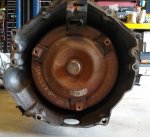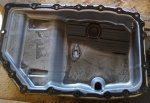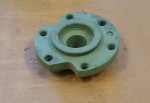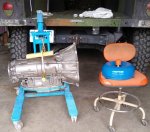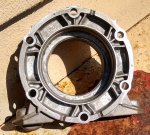- 7,513
- 10,538
- 113
- Location
- Papalote, TX
EDIT, as you read this thread I ended up using a 6L80 as the 6L90 was toast and the 6L80 has the same output shaft as the 4L80/3L80.
I was at a machine shop auction the other day and picked up a 6L90 with a MP1626XHD transfer case, it is complete with T/C, the front shaft, cooler lines and shift linkage so it looks like it was pulled out of a salvage vehicle.
So the wheels started turning and after some research it does look possible to install one in a HMMWV, there is one company selling stand alone controllers that only MUST have RPM and TPS to operate, it is actually about 1/2" shorter from the bell housing to the transfer case adapter VS a 4L80E which is amazing for a 6 speed, of course that little advantage is lost unless one adapts a smaller transfer case.
It has double overdrive with 6th being 0.677:1 VS 0.75:1 for the 4th in the 4L80E (the Allison is 0.614:1 in 6th)
It is much more efficient than that dinosaur 4L80 (This means more of the puny Detroit input HP will get to the output)
It has a MUCH lower 1st gear than the 4L80, 4.030:1 VS 2.480:1 but because it is a 6 speed the ratios are actually closer together than the 4L80.
Adding a ton of power to my DuraVee made a big difference but the 6 speed Allison with its double overdrive was the game changer for sure.
I will swap out the electric shift transfer case for one of the manual MP1226XHD units I have here. (the electric shift MP transfer cases have trouble in stand alone without a matching ECM)
I believe I will be the first to install a 6L80/90 in a HMMWV
I was at a machine shop auction the other day and picked up a 6L90 with a MP1626XHD transfer case, it is complete with T/C, the front shaft, cooler lines and shift linkage so it looks like it was pulled out of a salvage vehicle.
So the wheels started turning and after some research it does look possible to install one in a HMMWV, there is one company selling stand alone controllers that only MUST have RPM and TPS to operate, it is actually about 1/2" shorter from the bell housing to the transfer case adapter VS a 4L80E which is amazing for a 6 speed, of course that little advantage is lost unless one adapts a smaller transfer case.
It has double overdrive with 6th being 0.677:1 VS 0.75:1 for the 4th in the 4L80E (the Allison is 0.614:1 in 6th)
It is much more efficient than that dinosaur 4L80 (This means more of the puny Detroit input HP will get to the output)
It has a MUCH lower 1st gear than the 4L80, 4.030:1 VS 2.480:1 but because it is a 6 speed the ratios are actually closer together than the 4L80.
Adding a ton of power to my DuraVee made a big difference but the 6 speed Allison with its double overdrive was the game changer for sure.
I will swap out the electric shift transfer case for one of the manual MP1226XHD units I have here. (the electric shift MP transfer cases have trouble in stand alone without a matching ECM)
I believe I will be the first to install a 6L80/90 in a HMMWV
Last edited:





